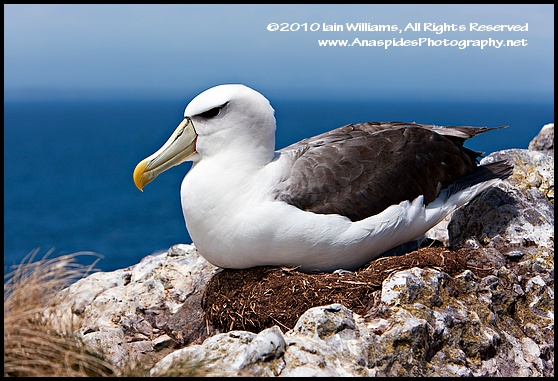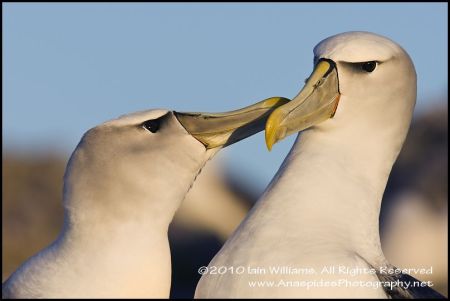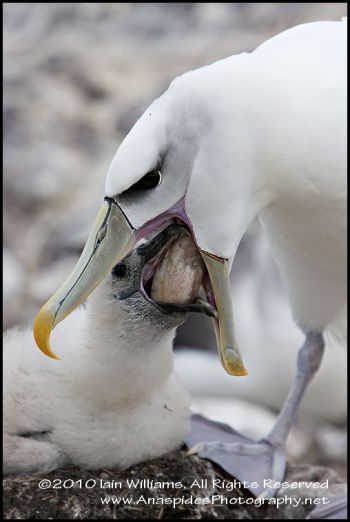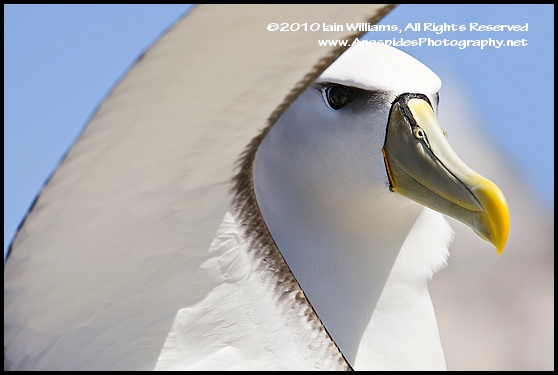Albino Shy Albatross Chick (Thalassarche cauta)
 Saturday, March 6, 2010 at 7:46PM
Saturday, March 6, 2010 at 7:46PM  On a recent field trip to islands off the coast of Tasmania, I observed a pair of non-albino Shy Albatross (Thalassarche cauta) tending an albino chick. This chick, which was very healthy in appearance. was the only youngster iin the 2 breeding colonies that showed albinism.
On a recent field trip to islands off the coast of Tasmania, I observed a pair of non-albino Shy Albatross (Thalassarche cauta) tending an albino chick. This chick, which was very healthy in appearance. was the only youngster iin the 2 breeding colonies that showed albinism.
LEFT: Albino Shy Albatross Chick (Thalassarche cauta) is feed a diet of squid.
Congenital hypopigmentary disorders, known as albinism, result from a defect in the production of pigment (melanin) in the skin, eyes, and hair. The condition is due to the dysfunction of the melanin producing cells. The condition can occur when offspring inherit a recessive gene. from either parent. The number of defective genes inherited determines the type of albinism.
Albinism affects both males and females, and is apparent from birth. From my reading on the subject there are three types of albinism: OCA type 1, OCA type 2 and OCA type 3; each presenting with slightly different symptoms.
Whilst albinism is not an uncommon occurrence in animal populations, it is an uncommon occurrence in groups of species that have relatively low population numbers, such as Shy Albatross. Boisey, R.E. (2003) states that OCA type 1 albinism occurs in 1 individual per 40,000 and OCA type 2 occurs in 1 individual per 15,000. There is little research to reflect the occurrence of OCA type 3.
In general, species that present with albinism are predated upon and selected out of the population. For example, an insect that is usually coloured white to blend in with its snow surroundings, but is black, will be predated upon and killed, removing it from the population. Usually a recessive gene (trait) has a negative impact on an individual, however, if the inherited trait provides an 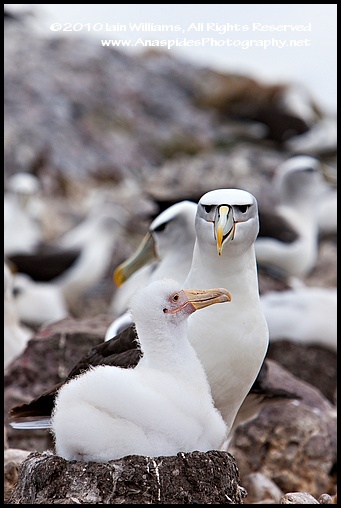 environmental benefit or sexual advantage, it maybe carried forward into future populations (natural & environmental selection).
environmental benefit or sexual advantage, it maybe carried forward into future populations (natural & environmental selection).
How albinism affects a bird such as the albatross is unknown, as generally these birds don't require effective camouflage to survive. However, albatross do require excellent eyesight in which to spot prey beneath the surface of the ocean. OCA type 1 and type 2 albinism causes sensitivity to light (photophobia), reduced visual acuity and involuntary eye twitching. OCA type 3 also has reduced visual ability but not to the same extent as type 1 and type 2. A lack of visual acuity would have an affect on an albatross once fully fledged.
An albino albatross may survive if the population of prey is great and easily found. However, if prey is difficult to find then I would suggest that an albino albatross may have difficulty feeding in the wild.
LEFT: Albino Shy Albatross Chick (Thalassarche cauta) and parent. The pink face is a very obvious characteristic if albinism.
Please note that I am not a geneticist by training and information for this post has been obtained from several sources.
I wish this little fellow the best of luck in the future as he/she transit the world’s oceans.



